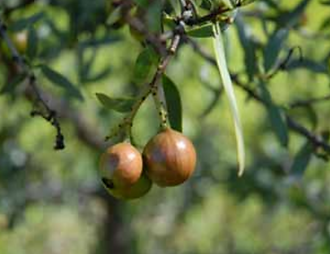
Welcome again to Scents of the Earth! Today I want to present to you one of my favorite materials from one of my favourite partners with Lingua Planta, Sandalwood from Western Australia from a project called 'Dutjahn'.
Santalum spicatum is native to the semi-arid regions of southern and western Australia. It is the oldest living fragrant species of Santalum, said to be some 13 million years old. Aboriginal people are custodians of this wood and crown it under the name of "Dutjahn."
I am so happy to be able to work together with Dutjahn and to offer you this precious oil today that comes from the arid Gibson dessert. It made a long journey to get here. It is quite special and I hope you love and know to appreciate it as much as I do.
Hello dear ones,

With love,
Merle
In your box this month:
Santalum Spicatum. OrganicWest Australian Sandalwood oil from the Gibson Desert.
Corresponding images, books and video's

First-aid
Sandalwood can be a great first-aid relieve if you have anxious tendencies.
It will linger on a handkerchief for some days and its scent could be very soothing. Also, I love to wear it on my skin. It is like a perfume on its own.

An article on Sandalwood and aromatherapy
Where Gabriel Mojay dives into the research and many benefits of Australian sandalwood (Santalum spicatum, Fusanus spicatus) oil, exploring its applications in traditional medicines and contemporary aromatherapy.

The constituents of Santalum Spicatum
As all natural materials, Sandalwood Spicatum is made up of many different kinds of molecules. Alpha-santanol leans towards the scent of cedar, Beta-santalol more towards a creamy and milky profile. Farnesol is quite floral and green. Nuciferol and Bergamotol, Lanceol and Bisabolol are not particularily known for their fragrances.
Each year and each supplier has its own scent profile and it might be interesting to compare the different constituents. Not only because of their scent, but also for their functions as aromatherapeutic agents.
A beautiful and vulnerable sharing of Aboriginal song & story
Lewis Burns performing at the Heart & Mind Festival. Even though Lewis comes from an that is closer to the lush, green, Sydney than the dry and dusty Gibson desert, the sentiments he shares in our relationship to the land and mother Earth is quite similar to that of Clinton Farmer of Dutjahn.
A song called Sandalwood

A bundle of heartwood
The heartwood is what is used to make the fragrant sandalwood oil, although I just received a sample of the dry wood, which is the non-heartwood part of the tree. Will come back to report my findings!
Our friend Clinton Farmer of Dutjahn
Talking about Sandalwood.
Find the origin of our Sandalwood on the map
I find it fascinating how long it takes to zoom out and see any kind of settlement or road. Imagine the vastness of this space when you smell this oil. Sandalwood trees and red Earth.

Sandalwood is a soothing basenote, that we work with in our perfumes Sacred Sun and Understory.
Reach out or say hi
Essential oil is made via steam distillation
Distillation is a method of separating components based on differences in volatile constituents in a heated mixture. Steam distillation involves bubbling steam through the plant material. The temperature of steam is easy to control, making it ideal for heat-sensitive essential oils. The essential oils contained in plants are immiscible in water and have a higher boiling point, allowing the essential oil to vaporize at a lower temperature than it normally would on its own.
We would love to personally connect with you, if you have any questions or are in need for some help, don't hesitate to reach out.
or DM @linguaplanta
For centuries, humans have considered themselves to be superior to other species, but recent research has challenged this notion. Scientists have discovered that plants communicate with one another and with other organisms through a language of scent.
This revelation offers a new perspective on the natural world and highlights the complexity and interconnectedness of all living things. Lingua Planta represents a profound shift in our understanding of the plant kingdom and challenges us to rethink our relationship with nature.
To celebrate the intelligence of plants and to evoke a perspective shift, we've created a line of perfumes chosen with plant ethics in mind. Our perfumes are crafted with care and attention to detail, ensuring that each fragrance is of the highest quality & friendly to all of Earth's inhabitants.

